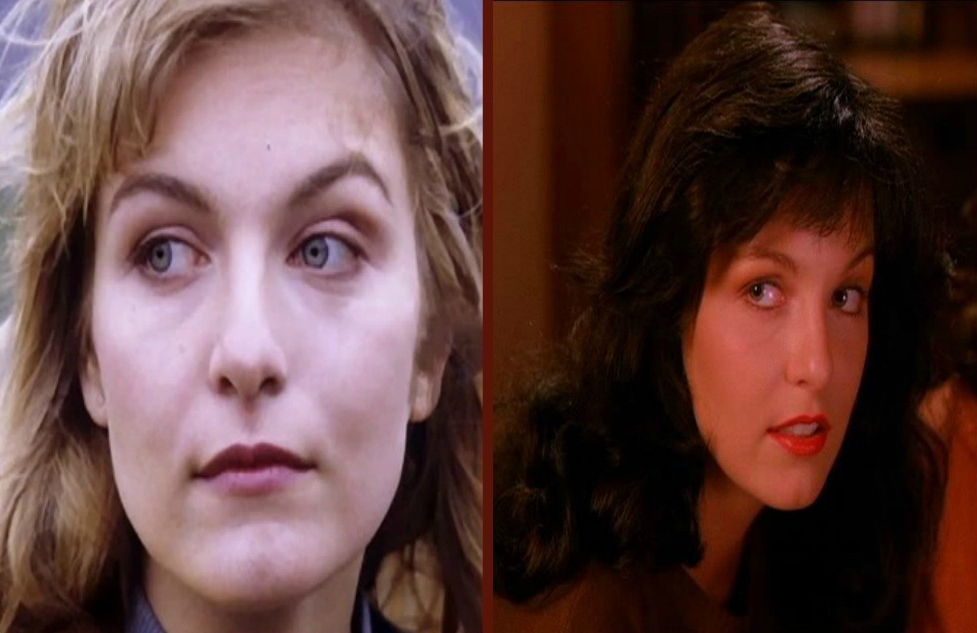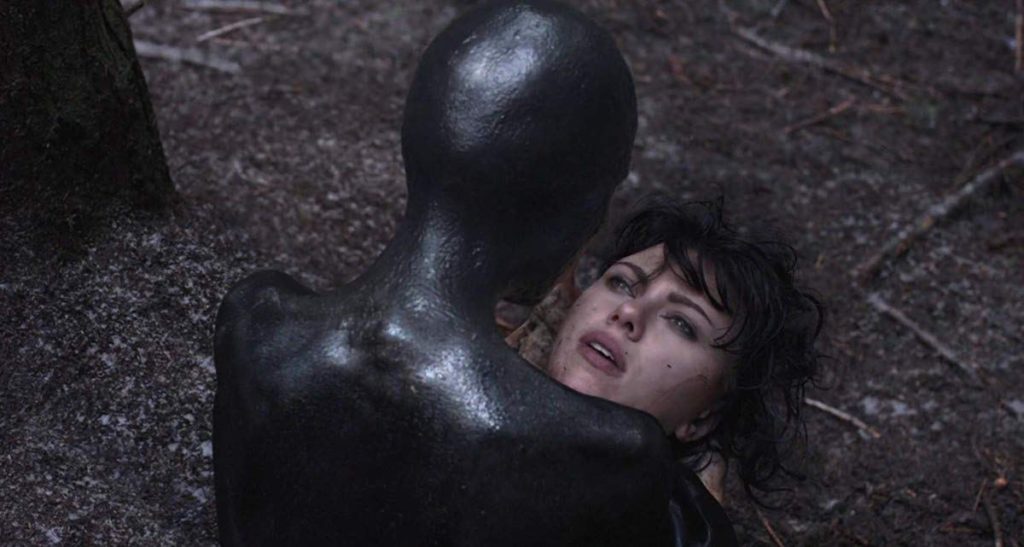[Continued from Part One last fortnight.]
The Star
A theory—one that I am sure others share—is that all Hitchcock’s blondes are one blonde, just as all fantasies are one fantasy. The faces and the clothes are swapped, bodies exchanged, but the same libidinous impulse is still there, erupting from the frame, unable to be repressed.
This is something at the core of David Lynch’s playful account of the Hitchcock blonde—one that acknowledges her role as a mythic Hollywood trope and the Möbius strip that runs between desire and violence, always hovering in an interstitial space where fear, yearning, and black comedy collapse into insanity and body horror. These exchanges persist throughout Lynch’s account of America’s dreamland, where the interplay between the blonde and her brunette sister, cousin, alter ego, or whatever, does more to address, rather than naturalise, cinema’s role as dream machine and the uncanny nature of its erotic currency. These women are literally duplicitous.

.
We see this in Twin Peaks (1991–2017), a sprawling television-series/film/transmedia hybrid that grabs the wholesome myth of small-town America by the throat and shakes it until it’s insensible. Poor dead, perfect blonde Laura Palmer, a troubled American sweetheart, and Maddy, her brunette cousin, are played by Sheryl Lee in a marvellously funny act of doubling. We see it too in Lost Highway (1997), a meandering dissociative fugue of a film, that features Patricia Arquette in the role of a brunette wife and a gangster’s blonde mistress—good girl, bad girl, round and round. This film is filled with explicit references to Hitchcock’s Vertigo, such that it feels like a spectral manifestation of the film summoned in some odd cinematic séance.

.
But Lynch grapples with this most perfectly in Mulholland Drive (2001), an extraordinary film that so disturbed me when I first saw it in the cinema that I wanted to throw up. Wholesome, wide-eyed blonde Betty (played by Naomi Watts) arrives in Hollywood as an aspiring actress and befriends a sensual brunette with car-crash-induced amnesia (played by Laura Harring, a former Miss USA). Betty dubs her ‘Rita’ for 1940s screen idol Rita Hayworth—one of many problems with the film has with identity and forgetfulness. As they investigate Rita’s origins, one woman gets confused with the other. It’s intense and unsettling, the brunette becomes blonde, they have sex, we don’t know who is who. The world begins to collapse on itself and the film is like an assault on the viewer. Suddenly, Watts is now Diane, a bitter, failed actress, and Harring is Camilla, a successful Hollywood star, whose rejection of Diane sparks jealousy and violence. Woven through this split narrative are multiple oddball storylines, taking place in spaces of LA where even everyday animals are conspicuous by their absence, bar a smear of dog shit in the courtyard of Betty’s flat. Where have all the animals gone? It’s unsettling, unreal. Perhaps people are the only animals.
Notably, the blondes in these knowing films recall every blonde in the pantheon of American celebrity—from Veronica Lake to Marilyn Monroe to Madonna—because Lynch is often playing with the figure of the star, the commodified dream woman, as part of his interrogation of the nature of cinema, dreaming, and reality. A running gag in Mulholland Drive is the patronising phrase ‘this is the girl’, which identifies a new starlet, a new film commodity, as much as it does a victim.
In Stars, his 1979 account of stardom, Richard Dyer notes that the ‘celebrity’ is a commodity manufactured by capitalist institutions and constructed through media, such as films and advertising. Stars are created to make money (actors and musicians sign with particular producers or studios); many become brands themselves. Dyer noted that, paradoxically, stars must be ordinary enough to be relatable, somehow ‘just like us’, but extraordinary enough to be idolised. They must be present within our everyday lives, their faces and voices all around us, yet absent, in that they are out of reach—on a pedestal or not really there. Stars need an audience. We complete their images by consuming their products or engaging with their story.

.
Recall, then, that the contemporary mythic blonde comes directly from this figure—Hollywood movie star Jean Harlow, the original ‘platinum blonde’ bombshell. Harlow’s natural colour was ash blonde, closer to mine. Her hairdresser said that the bright colour was achieved through the use of soap flakes, ammonia, and Clorox bleach. Don’t try this at home: it can create hydrochloric acid. Fans tried to dye their hair to match hers. There were even competitions. Poor Harlow died at twenty-six from kidney failure. Her life had been peppered with significant bouts of illness. But who knows what the effects of all those ghastly chemicals were. By that stage, her hair had been falling out for years.
The Void
Actress Scarlett Johansson, a Scandi blonde, is a bona fide star. In 2018 and 2019, she was the world’s highest-paid actress; Marvel films pay well. She’s very talented, immediately recognisable, and aware of her role as and alongside commodity. She is a brand ambassador for Dolce and Gabbana, and, in an ad for their fragrance The One, she both is and plays the part of the classy bombshell star. She’s flirtatious and distanced, flashbulbs going off in her face, lush orchestration in the background, her droll bon mots evoking Marilyn Monroe. Luxury, darling, nostalgia—but for what? It’s a layered account of the hyperreality and performativity of celebrity, because who can tell where Johanssen ends and the layers of monetised persona begin?

I highlight this to emphasise the importance of her casting in Jonathan Glazer’s eerie horror-drama Under the Skin (2015). Johanssen, who was attached to the project for so long that you know she really cared about doing it, plays a nameless creature—‘the female’—that takes the form of a human woman. Not the first and not the last of her sort, she wears scruffy slappery clothes, wears a shaggy black wig, and cruises around Glasgow, enticing unsuspecting, horny men to follow her—enchanted—into a dark, viscous void. Why wouldn’t you? She’s soft, coquettish. Even her probing questions, asking men whether they are alone or expected anywhere, read as engaged, not menacing. Protective colouration. The film is deliberately opaque and terrific in its aesthetics, music, and stylisation. Johanssen is an anglerfish’s pretty lamp, a shimmering artificial fly, and human men are meat, being harvested for alien consumers.
A key aspect of the film’s impact relies on our intertextual recognition of Johanssen as blonde-star figure. It offers a sophisticated rejoinder to Hitchcock’s appreciative, voyeuristic camera, its punishments of blonde women who are desired and hated. Honestly, it’s genius. We are conditioned as spectators to appreciate her beauty—she is meant to connote ‘to-be-looked-at-ness’—but the stilted, impersonal framing and cinematography refuses such objectification and identification, and it’s a source of tension. The female is blank, initially an automaton, all carefully programmed flirtatious predation, but with little actual agency. Johanssen gets naked—I think it’s her first film that features nudity—but, despite near-hysterical fan interest in her body and sexuality, here it’s flat, not sexy, and that’s a real act of subversion. She’s not an object for our visual consumption. She moves, through the film, from object to subjecthood. The longer she is in her constructed, disposable body, the more she experiences and learns, and with this embodiment comes a sort of awakening. It’s not a ‘becoming-human’, but it’s a type of individuation. This film, then, provokes uncomfortable questions about what it means to exist in a body, about the nature of sex and identity, and about the naturalisation of objectification. It’s also about animals, meat, and consumption. I recall feminist activist-scholar Carol J. Adams’s 1990 book The Sexual Politics of Meat, which charts the intersections of institutionalised misogyny and a culture obsessed with meat and masculinity. You will see this at play a little in Simnett’s The Udder, all girlhood, milk, and mastitis.
As such, Under the Skin asks us, ‘Why do you find this image enchanting?’ And then, like Simnett’s work, it turns us against it. We should know better, but become conditioned to Johanssen’s image and the memory of her blonde stardom, so, when we see the creature’s true, monstrous form at the film’s climax, it’s shocking. She is desired and hated for being desired. As she stumbles confused through the woods, a predatory logger tries to rape her and tugs her human skin away from her black-void body. He is so appalled at her inhumanity—despite already seeing her as less than human—that he sets her on fire. In a film that genuinely invites multiple and layered readings, it’s easy to recognise this as an account of the cult of celebrity, the pathological veneration and destruction of beauty, and the unknowability of the hidden self within.
So, the film is a tragedy, but powerfully moving. Hitchcock’s Marnie shifts our viewing position from Marnie to that of the sexually domineering bully, Mark; this film brings us closer to the creature, who was initially alienated and alienating. For while we are accustomed to the objectifying, voyeuristic male gaze, Under the Skin finishes with us looking out of the female’s eyes for the first time, as she stares up into falling snow for in a long, still take, before the screen goes black. Even though we know that, from the outside, she is disposable, beastly, and will be exchanged with another sexpot and another, in these final vulnerable moments we are truly with her. In spite of everything, she is a person, important and whole.
•
A sense of blurring or exchange occurs in so many stories about blondes, beasts, and bodies, where horror and delight walk hand in hand. Our role, as we encounter the challenging works here in the Gallery, isn’t just to take them in and move on—go get a beer, whatever—but to see where we fit within these layers of instability. In these abject fairy tales of femininity and metamorphosis, we are confronted with complex histories of representation and identity, and—we must remember—our own complicity with them.
—Erin Harrington
_
Erin Harrington is a senior lecturer at University of Canterbury Te Whare Wānanga o Waitaha. She is the author of Women, Monstrosity and Horror Film: Gynaehorror.
